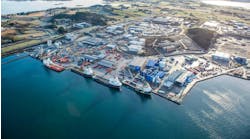Oil and gas industry research targets nanotechnology
The statement "there is no more easy oil" is commonplace in the oil and gas industry. It is an interesting observation: what the industry now considers "easy" was anything but when the technologies were introduced that opened up what now are considered easy-to-produce fields. The technologies that have allowed heavy oil production, ultra-deepwater drilling, and floating production were essential to the growth of the industry.
Today, work continues on the next generation of research and development, which includes disciplines that have never before been associated with oil and gas operations. One of the most interesting and promising of these is nanotechnology.
R&D efforts are taking place on a number of fronts. Houston's Rice University, for example, is involved in developing "nanoreporters" that are designed to change their molecular makeup depending on the medium they encounter (water, petroleum, or hydrogen sulfide) and to report data, including the temperature and pressure readings. Tags attached to the nanoreporters allow the scientists tracking the devices to determine how long the nanoreporters have been deployed.
Saudi Aramco has invested heavily in similar research through its Exploration and Petroleum Engineering Center - Advanced Research Center (EXPEC ARC) in Dhahran, Saudi Arabia. Researchers at EXPEC ARC are developing reservoir robots, or "resbots," designed for deployment in oil and gas reservoirs for the purpose of reporting data from the reservoir to the surface for improved reservoir management.
Additional industry research is focused on developing advanced coatings applications, including coatings for drill bits, lubricants and drilling mud, and pipelines.
Classification societies have embraced emerging technology, including nanotechnology, which has led to increased investment and greater cooperation with other stakeholders through pioneering joint development projects.
One example is work ABS has undertaken with George Washington University on nanosurface profiling technologies to develop and test ice-phobic coatings to mitigate ice accretion. By profiling the surface at the nano scale, researchers can modify the contact angle for water droplets such that they do not adhere, which means the droplets will not wet a treated surface. This technology could mitigate the risk of ice buildup in arctic conditions.
The aim of this project is to develop a testing standard to evaluate ice-phobic coating performance and will encompass an assessment not only of ice adhesion, but also of abrasion resistance, durability, and UV resistance. It is a trickier problem than it appears, in part because there are so many variables. For instance, the type and composition of ice accreted can be expected to differ between components and locations on the same vessel. This also is true for the same component installed on different vessels.
The potential application of ice-phobic surfaces is far reaching and includes the ability to liberate critical components such as lifeboat release mechanisms and navigation equipment from the debilitating effects of freezing sea spray and precipitation.
This ambitious project holds bold promise for improving safety in the Arctic developments that are anticipated in the next few years. Applying nanotechnology that will expand the operational window of Arctic operations has the potential to increase productivity considerably and to reduce operational interference due to inclement conditions.
In choosing to invest in nanotechnology R&D, ABS investigated the merits of 16 projects in the disciplines of energy efficiency, subsea, and offshore technology. While the ice-phobic nanostructured coatings project eventually won out, a project that nearly came out on top was one that addressed energy efficiency and weight-savings - a concern equally vital to the industry.
While fiber glass polymer matrix (FRP) structures are finding greater acceptance, they have some obvious drawbacks. One of these is the difficulty of accurate in-service inspection, and another is a greater vulnerability to impact than conventional building materials. Spurred on by successes in aerospace, researchers now believe they can develop an FRP that can repair itself. The repair works when resin and hardener nanocapsules lying dormant in their embedded state within the matrix are fractured by an event such as the formation of a micro-crack. The capsules release their contents, which cure to seal the crack. This is proving to be particularly appealing for large-scale FRP CNG pressure vessels.
The potential scope for applying these new technologies is broad, but more research is needed. As industry prepares to take on new challenges, technology is working to close the gaps.
Continued cooperative research efforts will be the key to developing the solutions that will extend the boundaries of what is possible in offshore exploration and development.
James Bond
Elli Lembessis
ABS
This page reflects viewpoints on the political, economic, cultural, technological, and environmental issues that shape the future of the petroleum industry. Offshore Magazine invites you to share your thoughts. Email your Beyond the Horizon manuscript to David Paganie at[email protected].


